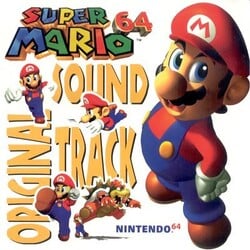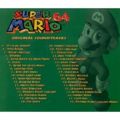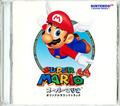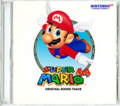Super Mario 64 Original Soundtrack: Difference between revisions
BBQ Turtle (talk | contribs) (→Track listing: Removing {{rewrite}}, converting to table, general clean-up, times from khinsider.) |
Murphmario (talk | contribs) No edit summary |
||
| (17 intermediate revisions by 6 users not shown) | |||
| Line 3: | Line 3: | ||
{{album infobox | {{album infobox | ||
|title=Super Mario 64 Original Soundtrack | |title=Super Mario 64 Original Soundtrack | ||
|image=[[File:mario64album.jpg| | |image=[[File:mario64album.jpg|250px]] | ||
|composer=[[Koji Kondo]] | |composer=[[Koji Kondo]] | ||
|publisher=Pony Canyon | |publisher={{wp|Pony Canyon}}, [[Nintendo]] | ||
|release={{release|Japan|July 19, 1996|USA|November 1, 1996|Europe|1997}} | |release={{release|Japan|July 19, 1996|USA|November 1, 1996|Europe|1997}} | ||
|media=Compact disc | |media=Compact disc | ||
| Line 13: | Line 13: | ||
}} | }} | ||
The '''''Super Mario 64 Original Soundtrack''''' is a video game album that was produced and copyrighted by [[Nintendo]] and published by {{wp|Pony Canyon}}. The album was released in Japan and North America in 1996 and Europe in 1997. The soundtrack has 34 tracks from [[Super Mario 64 | The '''''Super Mario 64 Original Soundtrack''''' is a video game album that was produced and copyrighted by [[Nintendo]] and published by {{wp|Pony Canyon}}. The album was released in Japan and North America in 1996 and Europe in 1997. The soundtrack has 34 tracks from ''[[Super Mario 64]]'' as well as the "It's a Me, Mario!" voice clip from the game's boot-up sequence; the final track is a bonus piano version of "[[Piranha Plant]]'s Lullaby" performed by [[Koji Kondo]]. The Japanese release is also the first of ten soundtracks in the ''[[Nintendo 64 Sound Series]]''. | ||
The soundtrack is featured in ''[[Super Mario 3D All-Stars]]'' alongside the ''[[Super Mario Sunshine]]'' and ''[[Super Mario Galaxy]]'' | The soundtrack is featured in ''[[Super Mario 3D All-Stars]]'' alongside the ''[[Super Mario Sunshine Original Soundtrack]]'' and ''[[Super Mario Galaxy Original Soundtrack]]'', albeit with a slightly altered version of the Japanese cover used to represent it. | ||
== | The soundtrack is also featured in the Super Mario Mash-up in ''[[Minecraft]]'', though "Dire, Dire Docks," "Looping Steps," and "Staff Roll" are the only songs not to be included. | ||
==Tracklist== | |||
{|class="wikitable" style="width:75%; margin-right:-1em;" | {|class="wikitable" style="width:75%; margin-right:-1em;" | ||
|- | |- | ||
| Line 27: | Line 29: | ||
|1 | |1 | ||
|"It's a Me, [[Mario]]!"<br>(Original title: "It's me, Mario!") | |"It's a Me, [[Mario]]!"<br>(Original title: "It's me, Mario!") | ||
|Voice: Charles Martinet | |Voice: [[Charles Martinet]] | ||
|0:04 | |0:04 | ||
|- | |- | ||
| Line 37: | Line 39: | ||
|3 | |3 | ||
|[[Princess Peach|Peach]]'s Message | |[[Princess Peach|Peach]]'s Message | ||
|Used when Peach reads her letter, as well as when the player collects enough [[Power Star]]s to open a [[Big Star Door]] | |Used when Peach reads her [[letter]], as well as when the player collects enough [[Power Star]]s to open a [[★ door]] or [[Big Star Door]] | ||
|0:09 | |0:09 | ||
|- | |- | ||
|4 | |4 | ||
|Opening | |Opening | ||
|Used when [[Lakitu]] first appears | |Used when one of the [[Lakitu Bros.]] first appears | ||
|0:35 | |0:35 | ||
|- | |- | ||
|5 | |5 | ||
| | |[[Super Mario 64 Main Theme]] | ||
|Used | |Used on the [[Bob-omb Battlefield]]; in [[Whomp's Fortress]]; on [[Tall, Tall Mountain]]; and on [[Tiny-Huge Island]] | ||
|2:22 | |2:22 | ||
|- | |- | ||
|6 | |6 | ||
|[[Slider]] | |[[Slider]] | ||
|Used in [[Rainbow Ride]], in [[Tick Tock Clock]], in the [[ | |Used in [[Rainbow Ride]], in [[Tick Tock Clock]], in the [[Slide (Super Mario 64)|slide]] areas, in most secret courses, and while the player races [[Koopa the Quick]] | ||
|2:50 | |2:50 | ||
|- | |- | ||
| Line 77: | Line 79: | ||
|11 | |11 | ||
|Snow Mountain | |Snow Mountain | ||
|Used | |Used on [[Cool, Cool Mountain]] and in [[Snowman's Land]] | ||
|2:58 | |2:58 | ||
|- | |- | ||
| Line 117: | Line 119: | ||
|19 | |19 | ||
|Correct Solution | |Correct Solution | ||
|Used when the player figures out a problem in any level | |Used when the player figures out a problem in any [[level]] | ||
|0:06 | |0:06 | ||
|- | |- | ||
| Line 137: | Line 139: | ||
|23 | |23 | ||
|Star Catch Fanfare | |Star Catch Fanfare | ||
|Used after Mario collects a Power Star | |Used after Mario collects a Power Star for the first time, and after clearing either of the first two Bowser courses | ||
|0:05 | |0:05 | ||
|- | |- | ||
| Line 147: | Line 149: | ||
|25 | |25 | ||
|Course Clear | |Course Clear | ||
|Used | |Used when Mario collects a Power Star | ||
|0:07 | |0:07 | ||
|- | |- | ||
| Line 157: | Line 159: | ||
|27 | |27 | ||
|Stage Boss | |Stage Boss | ||
|Used in | |Used in the four stage boss battles in the game: the [[King Bob-omb|Big Bob-omb]] on the Bob-omb Battlefield, the [[Whomp King]] in Whomp's Fortress, [[Eyerok]] in Shifting Sand Land, and Wiggler on Tiny-Huge Island | ||
|1:21 | |1:21 | ||
|- | |- | ||
|28 | |28 | ||
|Koopa's Message | |Koopa's Message | ||
|Used at the beginning of the game when the player enters the castle | |Used at the beginning of the game when the player enters the castle, as well as if the player tries to open an inaccessible door | ||
|0:06 | |0:06 | ||
|- | |- | ||
| Line 172: | Line 174: | ||
|30 | |30 | ||
|Koopa's Theme | |Koopa's Theme | ||
|Used in [[Bowser in the Dark World|Dark World]] and [[Bowser in the Fire Sea|Fire Sea]] Bowser battles | |Used in the [[Bowser in the Dark World|Dark World]] and [[Bowser in the Fire Sea|Fire Sea]] Bowser battles | ||
|2:30 | |2:30 | ||
|- | |- | ||
| Line 197: | Line 199: | ||
|35 | |35 | ||
|Staff Roll | |Staff Roll | ||
|Used in the [[List of Super Mario 64 staff| | |Used in the [[List of Super Mario 64 staff|end credits]] | ||
|3:27 | |3:27 | ||
|- | |- | ||
|36 | |36 | ||
|Piranha Plant's Lullaby – Piano<br>(Original title: Pakkun Flower's Lullaby) | |Piranha Plant's Lullaby – Piano<br>(Original title: Pakkun Flower's Lullaby) | ||
|Soundtrack only song | |Soundtrack-only song | ||
|2:23 | |2:23 | ||
|} | |} | ||
| Line 212: | Line 214: | ||
==Gallery== | ==Gallery== | ||
<gallery> | <gallery> | ||
SM64 SuperMario64STBack.jpg|Back cover of the soundtrack | |||
Soundtrack 64 JP-Super Mario 3D All-Stars.png|Japanese cover | Soundtrack 64 JP-Super Mario 3D All-Stars.png|Japanese cover | ||
SM3DAS SM64 Soundtrack CD.png|English cover from ''Super Mario 3D All-Stars'', based on the original Japanese cover | SM3DAS SM64 Soundtrack CD.png|English cover from ''Super Mario 3D All-Stars'', based on the original Japanese cover | ||
Latest revision as of 01:09, December 15, 2023
| It has been requested that at least one audio and/or video file related to this article be uploaded. Please upload all related music, sound effects, voice clips, or any videos for this article. See the help page for information on how to get started. |
| Super Mario 64 Original Soundtrack | |
|---|---|

| |
| Composed by: Koji Kondo | |
| Publisher(s) | Pony Canyon, Nintendo |
| Release date | |
| Media | Compact disc |
| Track(s) | 36 |
| Length | 51:14 |
| Catalog number(s) | PCCG-00357, 2090-Fall97 |
The Super Mario 64 Original Soundtrack is a video game album that was produced and copyrighted by Nintendo and published by Pony Canyon. The album was released in Japan and North America in 1996 and Europe in 1997. The soundtrack has 34 tracks from Super Mario 64 as well as the "It's a Me, Mario!" voice clip from the game's boot-up sequence; the final track is a bonus piano version of "Piranha Plant's Lullaby" performed by Koji Kondo. The Japanese release is also the first of ten soundtracks in the Nintendo 64 Sound Series.
The soundtrack is featured in Super Mario 3D All-Stars alongside the Super Mario Sunshine Original Soundtrack and Super Mario Galaxy Original Soundtrack, albeit with a slightly altered version of the Japanese cover used to represent it.
The soundtrack is also featured in the Super Mario Mash-up in Minecraft, though "Dire, Dire Docks," "Looping Steps," and "Staff Roll" are the only songs not to be included.
Tracklist[edit]
| # | Title | Origin | Length |
|---|---|---|---|
| 1 | "It's a Me, Mario!" (Original title: "It's me, Mario!") |
Voice: Charles Martinet | 0:04 |
| 2 | Title Theme | Used at the beginning of the game | 3:31 |
| 3 | Peach's Message | Used when Peach reads her letter, as well as when the player collects enough Power Stars to open a ★ door or Big Star Door | 0:09 |
| 4 | Opening | Used when one of the Lakitu Bros. first appears | 0:35 |
| 5 | Super Mario 64 Main Theme | Used on the Bob-omb Battlefield; in Whomp's Fortress; on Tall, Tall Mountain; and on Tiny-Huge Island | 2:22 |
| 6 | Slider | Used in Rainbow Ride, in Tick Tock Clock, in the slide areas, in most secret courses, and while the player races Koopa the Quick | 2:50 |
| 7 | Inside the Castle Walls (Original title: Castle) |
Used inside the Mushroom Castle | 2:00 |
| 8 | Looping Steps | Used when the endless stairs are in use | 0:28 |
| 9 | Dire, Dire Docks (Original title: Water) |
Used in Jolly Roger Bay; Dire, Dire Docks; and The Secret Aquarium | 3:06 |
| 10 | Lethal Lava Land (Original title: Fire Bubble) |
Used in Lethal Lava Land and Shifting Sand Land | 2:44 |
| 11 | Snow Mountain | Used on Cool, Cool Mountain and in Snowman's Land | 2:58 |
| 12 | Haunted House | Used in Big Boo's Haunt | 3:06 |
| 13 | Merry-Go-Round | Used in Big Boo's Haunt on the merry-go-round | 1:01 |
| 14 | Cave Dungeon | Main theme of the Hazy Maze Cave and Wet-Dry World; also heard in the Cavern of the Metal Cap, inside the pyramid of Shifting Sand Land, in the igloo of Snowman's Land, and in Wiggler's cave on Tiny-Huge Island; a cover version of the Super Mario Bros. Underground Theme | 3:46 |
| 15 | Piranha Plant's Lullaby (Original title: Pakkun Flower's Lullaby) |
Used in Whomp's Fortress when the player is near a Piranha Plant | 2:19 |
| 16 | Powerful Mario | Used when the player wears a Wing Cap or Vanish Cap, and when the player rides a Koopa Shell | 0:55 |
| 17 | Metallic Mario | Used when the player wears a Metal Cap | 0:55 |
| 18 | File Select | Used at the File Select screen | 0:44 |
| 19 | Correct Solution | Used when the player figures out a problem in any level | 0:06 |
| 20 | Toad's Message (Original title: Kinopio's Message) |
Used when the player talks to a Toad | 0:06 |
| 21 | Power Star | Used when the player frees a Power Star | 0:09 |
| 22 | Race Fanfare | Used when any type of race starts | 0:06 |
| 23 | Star Catch Fanfare | Used after Mario collects a Power Star for the first time, and after clearing either of the first two Bowser courses | 0:05 |
| 24 | Game Start | Used at the beginning of every main course | 0:05 |
| 25 | Course Clear | Used when Mario collects a Power Star | 0:07 |
| 26 | Game Over | Used after Mario runs out of lives | 0:17 |
| 27 | Stage Boss | Used in the four stage boss battles in the game: the Big Bob-omb on the Bob-omb Battlefield, the Whomp King in Whomp's Fortress, Eyerok in Shifting Sand Land, and Wiggler on Tiny-Huge Island | 1:21 |
| 28 | Koopa's Message | Used at the beginning of the game when the player enters the castle, as well as if the player tries to open an inaccessible door | 0:06 |
| 29 | Koopa's Road | Used in all Bowser courses | 2:11 |
| 30 | Koopa's Theme | Used in the Dark World and Fire Sea Bowser battles | 2:30 |
| 31 | Koopa Clear | Used after the player defeats Bowser and claims his key | 0:06 |
| 32 | Ultimate Koopa | Used in the final Bowser battle | 2:51 |
| 33 | Ultimate Koopa Clear | Used after the player clears the final Bowser battle | 0:28 |
| 34 | Ending Demo | Used when Mario is freeing Peach from the castle walls | 1:17 |
| 35 | Staff Roll | Used in the end credits | 3:27 |
| 36 | Piranha Plant's Lullaby – Piano (Original title: Pakkun Flower's Lullaby) |
Soundtrack-only song | 2:23 |
Super Mario 3D All-Stars description[edit]
The Nintendo 64 system gave this Mario adventure a more realistic instrumental sound than any prior game in the Super Mario series. This soundtrack enhanced player experiences with arrangements that smoothly transitioned between each 3D space.


